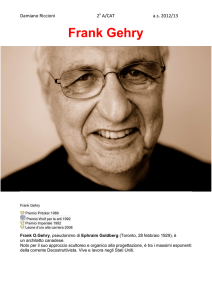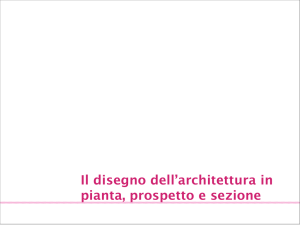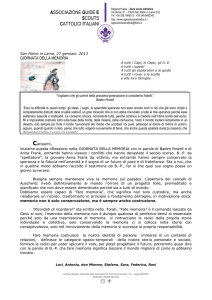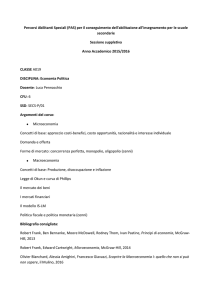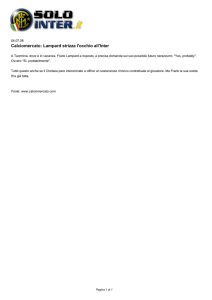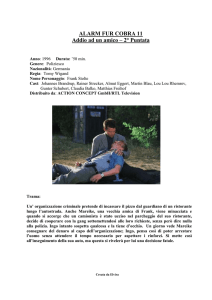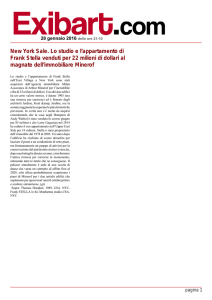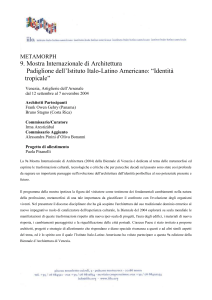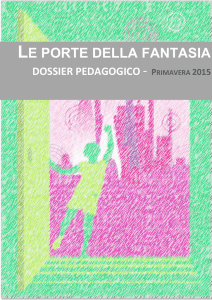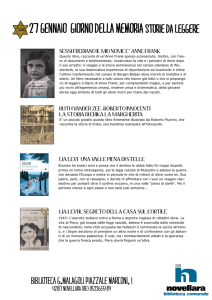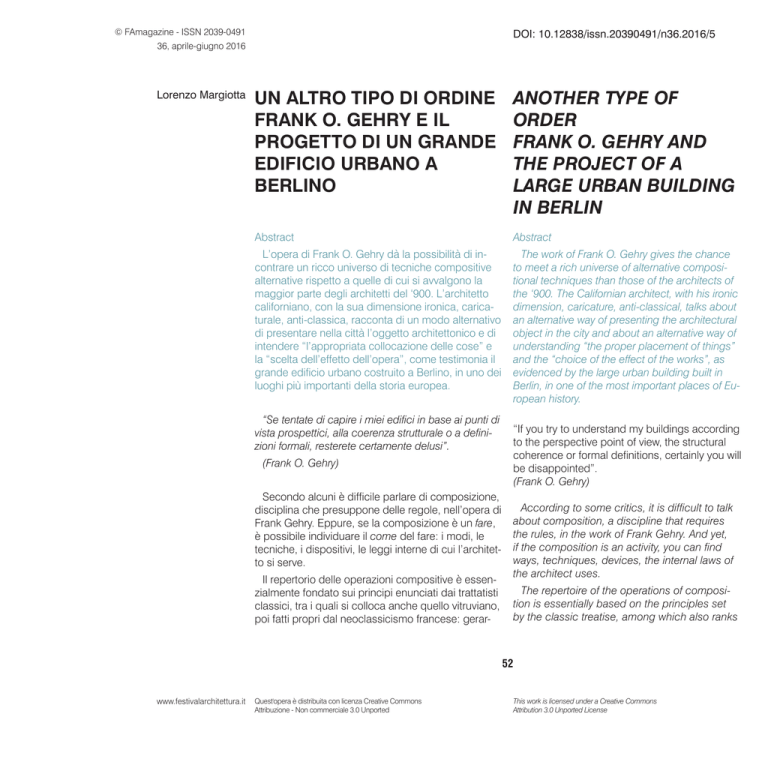
© FAmagazine - ISSN 2039-0491
36, aprile-giugno 2016
Lorenzo Margiotta
DOI: 10.12838/issn.20390491/n36.2016/5
Un altro tipo di ordine
Frank O. Gehry e il
progetto di un grande
edificio urbano a
Berlino
Another type of
order
Frank O. Gehry and
the project of a
large urban building
in Berlin
Abstract
Abstract
L’opera di Frank O. Gehry dà la possibilità di incontrare un ricco universo di tecniche compositive
alternative rispetto a quelle di cui si avvalgono la
maggior parte degli architetti del ‘900. L’architetto
californiano, con la sua dimensione ironica, caricaturale, anti-classica, racconta di un modo alternativo
di presentare nella città l’oggetto architettonico e di
intendere “l’appropriata collocazione delle cose” e
la “scelta dell’effetto dell’opera”, come testimonia il
grande edificio urbano costruito a Berlino, in uno dei
luoghi più importanti della storia europea.
The work of Frank O. Gehry gives the chance
to meet a rich universe of alternative compositional techniques than those of the architects of
the ‘900. The Californian architect, with his ironic
dimension, caricature, anti-classical, talks about
an alternative way of presenting the architectural
object in the city and about an alternative way of
understanding “the proper placement of things”
and the “choice of the effect of the works”, as
evidenced by the large urban building built in
Berlin, in one of the most important places of European history.
“Se tentate di capire i miei edifici in base ai punti di
vista prospettici, alla coerenza strutturale o a definizioni formali, resterete certamente delusi”.
(Frank O. Gehry)
Secondo alcuni è difficile parlare di composizione,
disciplina che presuppone delle regole, nell’opera di
Frank Gehry. Eppure, se la composizione è un fare,
è possibile individuare il come del fare: i modi, le
tecniche, i dispositivi, le leggi interne di cui l’architetto si serve.
Il repertorio delle operazioni compositive è essenzialmente fondato sui principi enunciati dai trattatisti
classici, tra i quali si colloca anche quello vitruviano,
poi fatti propri dal neoclassicismo francese: gerar-
“If you try to understand my buildings according
to the perspective point of view, the structural
coherence or formal definitions, certainly you will
be disappointed”.
(Frank O. Gehry)
According to some critics, it is difficult to talk
about composition, a discipline that requires
the rules, in the work of Frank Gehry. And yet,
if the composition is an activity, you can find
ways, techniques, devices, the internal laws of
the architect uses.
The repertoire of the operations of composition is essentially based on the principles set
by the classic treatise, among which also ranks
52
www.festivalarchitettura.it
Quest'opera è distribuita con licenza Creative Commons
Attribuzione - Non commerciale 3.0 Unported
This work is licensed under a Creative Commons
Attribution 3.0 Unported License
© FAmagazine - ISSN 2039-0491
36, aprile-giugno 2016
Frank O. Gehry, DZ Bank, Berlino, 1995-2001. Vista
della corte interna e della Conference hall / Frank
O. Gehry, DZ Bank, Berlin, 1995-2001. View of the
courtyard and the Conference Hall.
DOI: 10.12838/issn.20390491/n36.2016/5
chia tra le parti, simmetria, percezione prospettica
dello spazio, rapporti armonici nelle misure dei corpi, delle distanze, del ritmo. Difficilmente possiamo
sostenere che questo repertorio si trova ancora
nelle arti e nell’architettura del XX secolo, che hanno maturato una nuova coscienza del reale, nuove
intenzioni, un nuovo senso del fare. Sono stati battuti sentieri indipendenti, di volta in volta l’orizzonte
di ricerca è cambiato. Né Rem Koolhaas, né Peter
Eisenmann, né Zaha Hadid, né Frank Gehry fanno
composizione nel senso classico del termine. Ciò
che accomuna le diverse tendenze è la scelta di infrangere un sistema codificato e la proposizione di
un nuovo sistema di regole. Mentre nella musica ciò
è avvenuto, con Schönberg, attraverso la scomparsa della tonalità maggiore e minore, in architettura
questa tendenza porta all’abbandono dello spazio
prospettico, della simmetria, nella quale “l’occhio si
riposa”1.
the Vitruvian, then endorsed by French neoclassicism: the hierarchy between the parties, symmetry, perspective perception of space, harmonious relations in the sizes of bodies, distance,
pace. We can hardly argue that this repertoire is
still in the arts and architecture of the twentieth
century, who have gained a new awareness of
reality, new intentions, a new way of doing. They
were beaten paths independent from time to
time the research horizon has changed. Or Rem
Koolhaas, nor Peter Eisenmann, or Zaha Hadid
or Frank Gehry make composition in the classical sense of the term. What unites the different
trends is the choice to break a coded system
and the proposition of a new system of rules.
While this has happened in the music, with Schoenberg, through the disappearance of a major
and minor, in architecture this trend leads to
the abandonment of the perspective space, the
symmetry in which “the eye rests”1.
Il “Corso del Coltello”
The “Course of the Knife”
Nel 1985, in occasione della terza Mostra internazionale di Architettura di Venezia, diretta da Aldo
Rossi e intitolata Progetto Venezia, Frank Owen
Gehry è protagonista, insieme a Claes Oldenburg,
Coosje van Bruggen e Germano Celant, di una performance chiamata il Corso del Coltello2.
Frank O. Gehry, con Claes Oldenburg, Coosje van
Bruggen e Germano Celant, Il Corso del Coltello,
Venezia, 1985 / Frank O. Gehry, with Claes Oldenburg, Coosje van Bruggen and Germano Celant,
The Course of the Knife, Venice, 1985
Lorenzo Margiotta
Nella sua versione definitiva i tre attori giungono
nei pressi dell’Arsenale, teatro della rappresentazione, a bordo di una chiatta a forma di immenso
coltello svizzero. Gehry indossa un cappello a falda
a forma di pesce e un enorme timpano sulle spalle, dal quale penzolano molli colonne doriche. Nei
panni di Frankie P. Toronto – dove la P. stava per Palladio e Toronto per la sua città di nascita –, disegna
i propri schizzi, attraverso una lavagna luminosa,
direttamente sui più importanti palazzi veneziani.
Dal Co lo descrive come “una specie di manichino
dell’architettura classica, che prende in giro, con una
In 1985, at the third International Architecture
Exhibition of Venice, directed by Aldo Rossi and
entitled “Project Venice”, Frank Owen Gehry is
the protagonist, along with Claes Oldenburg,
Coosje van Bruggen and Germano Celant, of a
performance called “The Course of the Knife”2.
In its final version the three actors come
near the Arsenal, the theater of representation,
aboard a barge shaped like a huge swiss knife.
Gehry wearing a brimmed hat in the shape of
fish and a huge tympanum on the shoulders,
from which dangle soft Doric columns. In the
role of Frankie P. Toronto - where the P. was
about to Palladio and Toronto for his hometown
-, draw their sketches, through an overhead
projector, directly on the most important Venetian palaces. Dal Co describes it as “a sort of
un altro tipo di ordine. frank o. gehry e il progetto di un grande edificio
urbano a berlino
ANOTHER TYPE OF ORDER. FRANK O. GEHRY AND THE PROJECT FOR A LARGE
URBAN BUILIDING IN BERLIN
53
www.festivalarchitettura.it
Quest'opera è distribuita con licenza Creative Commons
Attribuzione - Non commerciale 3.0 Unported
This work is licensed under a Creative Commons
Attribution 3.0 Unported License
© FAmagazine - ISSN 2039-0491
36, aprile-giugno 2016
DOI: 10.12838/issn.20390491/n36.2016/5
certa disinvoltura, il linguaggio adottato da poco dai
postmoderni, pronto per il carnevale di Venezia. Recitando la parte del jolly nel mazzo di carte dell’architettura degli anni ‘80, Gehry deprecava la pomposità
di tanto progettare contemporaneo”3.
Questa performance rappresenta per Gehry una
sorta di manifesto sul tema del passato, come lui
stesso afferma: “Essere al centro di Venezia, così
vicino a Palladio – e tantissima architettura oggi fa
riferimento a Palladio – e parlare di disordine, di un
altro tipo di ordine, è un po’ irriverente… La cultura
occidentale pensa a un solo tipo di ordine… alla
simmetria, al classicismo, all’idea della prospettiva
centrale. Ma il mondo intero non può essere costruito soltanto lungo degli assi”4.
mannequin of classical, teasing, with some
confidence, the language adopted recently by
the post-modern, ready for the Carnival of Venice. Playing the part of the joker in the pack of
cards of the architecture of the ‘80s, Gehry deplored the pomposity of contemporary design”3.
This performance is a kind of manifesto for
Gehry on the past, as he himself says: “Being in
the center of Venice, so close to Palladio - and
lots of architecture today refers to Palladio - and
speak of disorder, another type of order, is a bit
irreverent... Western culture thinks of only one
type of order... to symmetry, to classicism, the
idea of the central perspective. But the world
can not be built only along the axes”4.
DZ Bank, Berlino (1995-2001)
DZ Bank, Berlin (1995-2001)
“Credo che questo sia uno dei miei progetti miglio“I think this is one of my best projects. The
ri. I prospetti non sono frutto di compromessi. Questa prospects are not the result of compromises.
costruzione rappresenta la sintesi di tutte le impresThis building represents the synthesis of all
5
sioni e i sentimenti che Berlino suscita in me” .
the impressions and feelings that Berlin gives
me”5.
(Frank O. Gehry)
(Frank O. Gehry)
Progettare un edificio su Pariser Platz, al cospetto della Porta di Brandeburgo, significa lavorare in
un’area urbana critica, uno dei luoghi più importanti
della storia d’Europa.
Gehry risolve il fronte principale disegnando una rigorosa facciata di cinque ordini sovrapposti, rivestita
da grandi lastre di pietra di Vicenza. La facciata, costruita come un tempio classico, è scandita da sette
aperture, profondamente incassate, che generano
ombre profonde e le conferiscono spessore e peso,
accentuandone la natura fortemente tettonica.
Frank O. Gehry, con Claes Oldenburg, Coosje van
Bruggen e Germano Celant, Il Corso del Coltello,
Venezia, 1985 / Frank O. Gehry, with Claes Oldenburg, Coosje van Bruggen and Germano Celant,
The Course of the Knife, Venice, 1985
Come è stato osservato, “la mancanza di limiti e
conclusioni è il tratto caratteristico di questa facciata, (…) che esibisce unicamente la propria indefinita
ripetibilità in un luogo dove ogni costruzione è ca-
Lorenzo Margiotta
un altro tipo di ordine. frank o. gehry e il progetto di un grande edificio
urbano a berlino
Design a building on Pariser Platz in front of
the Brandenburg Gate, it means working in a
critique urban area, one of the most important
in the history of Europe.
Gehry solves the main front by drawing a strict
facade of five overlapping orders, covered with
large stone slabs of Vicenza. The façade, built
as a classical temple, is punctuated by seven
openings, deeply set, generating deep shadows and give it thickness and weight, emphasizing the highly tectonic.
As has been noted, “the lack of limits and
conclusions is the characteristic feature of this
facade, (...) that performs only its indefinite
ANOTHER TYPE OF ORDER. FRANK O. GEHRY AND THE PROJECT FOR A LARGE
URBAN BUILIDING IN BERLIN
54
www.festivalarchitettura.it
Quest'opera è distribuita con licenza Creative Commons
Attribuzione - Non commerciale 3.0 Unported
This work is licensed under a Creative Commons
Attribution 3.0 Unported License
© FAmagazine - ISSN 2039-0491
36, aprile-giugno 2016
DOI: 10.12838/issn.20390491/n36.2016/5
muffata come irripetibile”6. Il suo fronte volutamente
incompleto si offre come un “frammento scostante,
(…) una presenza stridente rispetto a tutto ciò che lo
circonda, dalle aggraziate e apparentemente colte
cortine edilizie”7.
repeatability in a place where every building
is disguised as unrepeatable”6.His face deliberately incomplete is offered as a “fragment
unfriendly, (...) a strident presence compared
to everything around him, from the graceful and
seemingly educated building facades”7.
Ma il riserbo del fronte principale è puro inganno.
Dietro la sua facciata “contestuale”, accuratamente
But the reticence of the main front is pure decostruita, l’edificio nasconde un altro racconto, di cui ceit. Behind its “contextual”, carefully constructnulla traspare all’esterno.
ed, the building hides another story, of which
nothing shines outside. In Berlin, city-theater
A Berlino, città-teatro per eccellenza, Gehry tratta
la facciata come un gigantesco sipario: “I suoi pieni par excellence, Gehry uses the facade like a
giant curtain: “Its full and its voids are shadows
e i suoi vuoti sono le ombre prodotte dalle pieghe
produced by the folds of velvet. Behind these
del velluto. Dietro a queste pieghe, a differenza di
quanto accade in tante altre costruzioni della nuova folds, unlike what happens in many other constructions of the new Berlin, the space underBerlino, lo spazio subisce un’orripilazione”8.
goes a process of mostrificazione”8.
Il prospetto posteriore dell’edificio, che si affaccia
The rear elevation of the building, overlooking
su Behrenstrasse, con una successione di nove
Behrenstrasse, with a succession of nine floors
piani di appartamenti, ha un carattere del tutto difof apartments, has a completely different charferente. La sua superficie, anch’essa in Pietra di
Vicenza, disegna un fronte ondulato che rende l’edi- acter. Its surface, which is also built in Vicenza
Vista del fronte dell’edificio con la Porta di Brandeburgo / View of the front of the building and the
Brandenburg Gate.
Lorenzo Margiotta
un altro tipo di ordine. frank o. gehry e il progetto di un grande edificio
urbano a berlino
ANOTHER TYPE OF ORDER. FRANK O. GEHRY AND THE PROJECT FOR A LARGE
URBAN BUILIDING IN BERLIN
55
www.festivalarchitettura.it
Quest'opera è distribuita con licenza Creative Commons
Attribuzione - Non commerciale 3.0 Unported
This work is licensed under a Creative Commons
Attribution 3.0 Unported License
© FAmagazine - ISSN 2039-0491
36, aprile-giugno 2016
DOI: 10.12838/issn.20390491/n36.2016/5
ficio, almeno da un punto di vista prospettico, meno
imponente. Le proporzioni di entrambe le facciate
sono commisurate con l’area urbana con la quale
ciascuna si confronta.
Il complesso si apre al centro in una grande corte
interna, di 61 metri per 20, coperta da un enorme
lucernario. Al centro della corte, leggermente rialzata
e raggiungibile attraverso sei percorsi, una struttura
cava rivestita esternamente di acciaio inossidabile, a
forma di “testa di cavallo”, ospita la sala conferenze,
che poggia su un pavimento vetrato e incurvato.
I quattro fronti interni, rivestiti in legno, sono scanditi in cinque ordini, corrispondenti a quelli della
facciata su Pariser Platz,. Essi appaiono come veri e
propri fronti urbani che delimitano una “piazza” coperta.
stone, draws a wavy face that makes the building, at least from a perspective point of view,
less imposing. The proportions of both sides
are commensurate with the urban area with
which each is compared.
The complex is opened at the center in a large
courtyard, 61 meters by 20, covered by a huge
skylight. At the center of the court, slightly elevated and accessible via six footbridges, a hollow structure externally coated stainless steel, in
the shape of “horse head”, hosting the conference room, resting on a glass floor and arched.
The four internal fronts, covered with wood, are
scanned in five rows, corresponding to those of
the facade on Pariser Platz. They appear as real
urban fronts bordering a “square” covered.
Composition of three elements
Composizione di tre elementi
Osservando i successivi modelli di studio si nota
come l’architetto assegni un ruolo decisivo a tre
elementi della composizione: la sala conferenze;
la copertura vetrata che la sovrasta; il pavimento,
anch’esso vetrato.
Looking at the next study models is known
as the architect assigns a decisive role in the
composition of three elements: the conference
room; the glass roof that dominates; the floor,
which is also glazed.
“Durante il concorso abbiamo posizionato una forma scultorea nel centro della corte (…) per mostrare
che volevamo creare un elemento di contrasto nel
centro della scatola rettangolare di legno (…). La
forma astratta acquisì una presenza e un potere che
aumentava via via che eliminavamo dalla corte gli altri
elementi”.
“During the competition we placed a sculptural form in the center of the court (...) to show
that we wanted to create an element of contrast
in the center of the rectangular wooden box
(...). The abstract form acquired a presence
and a power that was increasing as we eliminated the other elements from the court”.
They are not individually developed: the modiEssi non sono sviluppati individualmente: la modificazione dell’uno e dell’altro provoca la modificazione fication of both causes the modification of the
other two, in a concatenation of uninterrupted
degli altri due, in una concatenazione ininterrotta di
variants.
varianti.
Modelli di studio dell’edificio DZ Bank / Study's
model of the DZ Bank
(Frank O. Gehry)
(Frank O. Gehry)
At the heart of the tensions, the space beLorenzo Margiotta
un altro tipo di ordine. frank o. gehry e il progetto di un grande edificio
urbano a berlino
ANOTHER TYPE OF ORDER. FRANK O. GEHRY AND THE PROJECT FOR A LARGE
URBAN BUILIDING IN BERLIN
56
www.festivalarchitettura.it
Quest'opera è distribuita con licenza Creative Commons
Attribuzione - Non commerciale 3.0 Unported
This work is licensed under a Creative Commons
Attribution 3.0 Unported License
© FAmagazine - ISSN 2039-0491
36, aprile-giugno 2016
DOI: 10.12838/issn.20390491/n36.2016/5
Modello ligneo del fronte su Behrenstrasse / Wooden model of the front on Behrenstrasse
Spaccato assonometrico. Ridisegno dell’autore /
Axonometry. Redesign of the author
Pianta piano 1. Ridisegno dell’autore / Floor Plan 1.
Redesign of the author
Sezione longitudinale. Ridisegno dell’autore / Longitudinal section. Redesign of the author
Lorenzo Margiotta
ANOTHER TYPE OF ORDER. FRANK O. GEHRY AND THE PROJECT FOR A LARGE
URBAN BUILIDING IN BERLIN
un altro tipo di ordine. frank o. gehry e il progetto di un grande edificio
urbano a berlino
57
www.festivalarchitettura.it
Quest'opera è distribuita con licenza Creative Commons
Attribuzione - Non commerciale 3.0 Unported
This work is licensed under a Creative Commons
Attribution 3.0 Unported License
© FAmagazine - ISSN 2039-0491
36, aprile-giugno 2016
DOI: 10.12838/issn.20390491/n36.2016/5
Al centro delle tensioni, nello spazio interposto tra
le due membrane di vetro, appare la forma scultorea della “testa di cavallo”, nella quale culmina la
“messa in scena” realizzata da Gehry, regista di un
Disegno dell’autore che evidenzia la Conference sorprendente spettacolo teatrale.
hall come “forma generatrice” intorno alla quale si
“avvolge” la copertura / The drawing by the author
shows the Conference hall as “form-generating”
tween the two membranes of glass, appears
the sculptural form of the “horse head”, which
culminates in the “staging” built by Gehry, director of an amazing theatrical show.
The horse’s head
La testa del cavallo
La forma della conference hall, lunga 29 metri, larga 12 e alta 10, è stata desunta da un modello fisico
che è stato poi digitalizzato in un modello di superfici tridimensionali con il software CATIA. La sua
struttura è formata da una sequenza di travi in ferro
sagomate secondo le sezioni del volume, disposte
a intervalli regolari di 80 cm e collegate da traversi
Schizzo di Frank O. Gehry della sezione longitudinatubolari di 10 cm. Le immagini delle sue fasi costrutle dell’edificio / Sketch of Frank O. Gehry, longitudinal section of the building tive ne esaltano il carattere osteologico e ricordano
grandi scheletri di antichi animali.
The shape of the conference hall, 29 meters
long, 12 wide and 10 high, was derived from a
physical model which was then scanned into
a model of three-dimensional surfaces with
the CATIA software. Its structure is formed by a
sequence of iron beams shaped according to
the sections of the volume, arranged at regular
intervals of 80 cm and connected by tubular
cross-members 10 cm. The images of its construction phases enhance the character and
remind osteological large skeletons of ancient
animals.
“Mentre avveniva questa manipolazione la forma
diventava più morbida e biomorfica. Cominciava ad
assumere una presenza animale che non era né mai
vista né aspettata”9.
“While this was happening manipulating the
shape became more soft and biomorphic. He
began to have a presence that was neither animal nor ever expected”9.
(Frank O. Gehry)
(Frank O. Gehry)
Al di sopra delle “ossa”, la “carne” è formata da
spessi pannelli coibentanti, rivestiti da più di 100 piastre curve tridimensionali di acciaio inossidabile di
circa 150x250 cm. È un tessuto nervoso in movimento, attraversato da una tensione che culmina nella
cavatura dell’occhio, come uno squarcio inflitto sul
lato destro della testa, provocata dalla sottrazione di
un foglio del rivestimento.
Allargando lo sguardo dall’oggetto architettonico
allo spazio della corte in cui è inserito, si può osservare come Gehry utilizzi la tecnica compositiva
secondo cui una forma complessa, se inserita in
La Conference Hall in costruzione / The Conference
Hall under construction un contenitore semplice, aumenta la propria forza
espressiva. È difficile, infatti, immaginare questo ediLorenzo Margiotta
Above the “bones”, the “meat” is formed by
thick insulating panels, coated with more than
100 plates three-dimensional curves of stainless steel of about 150x250 cm. It is a nervous
tissue in motion, traversed by a tension that culminates in the cavity of the eye, such as a gash
inflicted on the right side of the head, caused
by the subtraction of a sheet of the coating.
Turning our attention from the object to the
architectural space of the court in which it is
inserted, it can be seen as Gehry uses the
compositional technique that a complex form,
when placed in a simple container, increases
its expressive power. It is difficult, in fact, to
un altro tipo di ordine. frank o. gehry e il progetto di un grande edificio
urbano a berlino
ANOTHER TYPE OF ORDER. FRANK O. GEHRY AND THE PROJECT FOR A LARGE
URBAN BUILIDING IN BERLIN
58
www.festivalarchitettura.it
Quest'opera è distribuita con licenza Creative Commons
Attribuzione - Non commerciale 3.0 Unported
This work is licensed under a Creative Commons
Attribution 3.0 Unported License
© FAmagazine - ISSN 2039-0491
36, aprile-giugno 2016
DOI: 10.12838/issn.20390491/n36.2016/5
ficio senza la “testa di cavallo” al suo interno. Anche
se dal punto di vista funzionale non cambierebbe
granché, le forme degli altri elementi architettonici,
che da essa dipendono, non avrebbero alcun senso:
non lo avrebbe la copertura né il pavimento, le cui
linee non troverebbero alcuna giustificazione.
imagine this building without the “horse head”
inside. Although from functional point of view
would not change much, shapes of the other
architectural elements, which are dependent on
it, would not have any sense: would not cover
neither the floor, whose lines would not find any
justification.
Un modo alternativo di presentare nella città
l’oggetto architettonico
An alternative way to present the city the
architectural object
Il gigantesco bucranio, dal tono dadaista, è un colpo di teatro, e in quanto tale è volutamente ambiguo.
The giant bucranium, from Dadaist tone, is
È l’atto imprevisto all’interno del racconto convena coup de theater, and as such is deliberately
zionale di un edificio a corte. È come un intruso, che ambiguous. It is the unexpected act inside the
però diventa l’identità dell’intero edificio.
conventional story of a courtyard building. It’s
Può esprimere ironia verso il mondo delle banche, like an intruder, but becomes the identity of the
entire building.
ma può anche avere un senso legato all’ebraismo,
alla violenza subita, alla crudeltà, a un desiderio di
vendetta, accentuato dal fatto che si trovi a Berlino.
It can express irony to the world of banks, but
it can also make sense tied to Judaism, to violence, to cruelty, to a desire for revenge, accentuated by the fact that you are in Berlin.
Non è solo un’operazione estetica, non ha soltanto
intenzione provocatoria, non è appena il montaggio
di immagini reperite all’interno della natura, di cui poi
viene fatta la caricatura. O, meglio, è tutto questo. È
una testa mozzata che rompe l’ordine dell’edificio.
Un mostro (dal latino “monstrum”, meraviglia) che,
“con la sua apparente, radicale gratuità evoca gli innumerevoli mostri di cui Berlino cerca inutilmente di
liberarsi”10.
Ma soprattutto racconta di un modo alternativo
– profondamente dialettico, teatrale e carico di significati e interpretazioni – di presentare nella città
l’oggetto architettonico, di intendere “l’appropriata
collocazione delle cose” e la “scelta dell’effetto
dell’opera”, e di sviluppare il rapporto tra architettura
e città contemporanea.
It is not merely a cosmetic, not only intention
provocative, not just the assembly of images
found in nature, which then is caricatured. Or,
rather, is this. It’s a severed head that breaks
the order of the building. A monster (from the
Latin “monstrum”, marvel) that, “with its apparent radical gratuity evokes the innumerable
monsters of which Berlin tries in vain to break
free”10.
But above all it tells of an alternative way –
deeply dialectical, theatrical and full of meanings and interpretations – to present the architectural object in the city, to understand “the
proper placement of things” and the “choice of
the effect of the work” and to develop the relationship between architecture and the contemporary city.
Il rivestimento in pannelli di acciaio inossidabile /
The stainless steel panels
Lorenzo Margiotta
un altro tipo di ordine. frank o. gehry e il progetto di un grande edificio
urbano a berlino
another type of order. frank o. gehry and the project of a large
urban building in berlin
59
www.festivalarchitettura.it
Quest'opera è distribuita con licenza Creative Commons
Attribuzione - Non commerciale 3.0 Unported
This work is licensed under a Creative Commons
Attribution 3.0 Unported License
© FAmagazine - ISSN 2039-0491
36, aprile-giugno 2016
DOI: 10.12838/issn.20390491/n36.2016/5
Note
Queste considerazioni trovano una trattazione più diffusa in A.
Gallo (a cura di), The Clinic of Dissection of Art, Marsilio Editori,
Venezia 2012.
2
Il progetto era nato un anno prima, nel 1984, quando Celant
chiamò i tre americani a condurre un workshop di architettura
e arte, intitolato “Il Corso del Coltello”, con gli studenti del Politecnico di Milano. Quell’estate, a New York, la rivista “Artforum”
pubblicò i progetti della performance.
3
F. Dal Co, Dalla bocca della verità, ovvero del cavallo, in F. Dal
Co, Kurt W. Forster, H. Soutter Arnold (a cura di), Frank O. Gehry. Tutte le opere, Electa, Milano, 1998, p. 34.
4
G. Celant (a cura di), The Course of the Knife. Claes Oldenburg, Coosje van Bruggen, Frank O. Gehry, Rizzoli International, New York 1986, p. 67.
5
F. O. Gehry, Costruire su Pariser Platz. Considerazioni sulla
nuova Berlino, in "Casabella" n.704, ottobre 2002.
6
F. Dal Co, Frank Gehry: i mostri dentro Berlino, in "Casabella",
n. 691, luglio-agosto 2001.
7
Ibid.
8
Ibid.
9
F. Dal Co, Kurt W. Forster, H. Soutter Arnold (a cura di), Op.
cit.
10
F. Dal Co, Frank Gehry: I mostri..., cit.
Notes
1
These considerations are treated in A. Gallo (edited by),
The Clinic of Dissection of Art, Marsilio Editori, Venice
2012.
2
The project was born a year before, in 1984, when Celant called the three Americans to conduct a workshop on
architecture and art, entitled The Course of the Knife, with
students of the Politecnico di Milano. That summer, in New
York, the magazine Artforum published the projects performance.
3
F. Dal Co, Kurt W. Forster, H. Soutter Arnold (edited by),
Frank O. Gehry. The complete works, Electa, Milan, 1998.
4
G. Celant (edited by), The Course of the Knife. Claes Oldenburg, Coosje van Bruggen, Frank O. Gehry, Random
House, New York 1986.
5
F. O. Gehry, Building on Pariser Platz. Considerations on
the new Berlin, in Casabella 704, October 2002.
6
F. Dal Co, Frank Gehry: the monsters in Berlin, in Casabella, 691, July-August 2001.
7
Ibid.
8
Ibid.
9
F. Dal Co, Kurt W. Forster, H. Soutter Arnold (edited by),
Op. cit.
10
F. Dal Co, Frank Gehry: I mostri..., cit.
un altro tipo di ordine. frank o. gehry e il progetto di un grande edificio
urbano a berlino
another type of order. frank o. gehry and the project of a large
urban building in berlin
1
Modello in Alias della “testa di cavallo”. Ridisegno
dell’autore / Model of the “horse head”. Redesign
of the author
Frank O. Gehry e il modello dell’edificio / Frank O.
Gehry and model of the building
Lorenzo Margiotta
60
www.festivalarchitettura.it
Quest'opera è distribuita con licenza Creative Commons
Attribuzione - Non commerciale 3.0 Unported
This work is licensed under a Creative Commons
Attribution 3.0 Unported License
© FAmagazine - ISSN 2039-0491
36, aprile-giugno 2016
DOI: 10.12838/issn.20390491/n36.2016/5
Bibliografia / References
A. Gallo (a cura di), (2012). The Clinic of Dissection of Art. Venezia: Marsilio Editori.
F. Dal Co, Kurt W. Forster, H. Soutter Arnold (a cura di), (1998). Frank O. Gehry. Tutte le opere. Milano: Electa.
G. Celant (a cura di) (1986). The Course of the Knife. Claes Oldenburg, Coosje van Bruggen, Frank O. Gehry. New York: Rizzoli International.
F. O. Gehry, Costruire su Pariser Platz. Considerazioni sulla nuova Berlino, in Casabella n.704, ottobre 2002.
F. Dal Co, Frank Gehry: i mostri dentro Berlino, in Casabella, n. 691, luglio-agosto 2001.
Lorenzo Margiotta
Lorenzo Margiotta, laureato nel 2009 alla Facoltà di Architettura
Civile del Politecnico di Milano con una tesi su Carlo De Carli
(relatore Prof. M. Biraghi), nel marzo 2014 consegue il tiolo di
dottore di ricerca in Composizione Architettonica allo IUAV, con
tesi su Frank O. Gehry e le tecniche compositive alternative
nell’architettura contemporanea (relatore Prof. L. Semerani).
È cultore della materia nel Laboratorio di Progettazione
Architettonica 1 del Prof. T. Monestiroli presso la Scuola di
Architettura Urbanistica e Ingegneria delle Costruzioni del
Politecnico di Milano.
Nel 2010 partecipa al “progetto per lo Scalo Farini” di Milano
guidato dallo studio Monestiroli Architetti Associati.
È membro del Consiglio direttivo dell’“Associazione Giovanni
Testori”.
Lorenzo Margiotta, graduated in 2009 from the Faculty of
Architecture of the Politecnico di Milano with a thesis on
Carlo De Carli (supervisor Prof. M. Biraghi), in March 2014
obtained a PhD in Architectural Composition at IUAV with
a thesis on Frank O. Gehry and alternatives compositional
techniques in contemporary architecture (supervisor Prof.
L. Semerani). He is teaching assistant in the Laboratory of
Architectural Design 1 of Prof. T. Monestiroli at the School
of Architecture, Urbanism and Construction Engineering of
Politecnico di Milano.
In 2010 he participates in the “Project on Scalo Farini” in
Milan led by the study Monestiroli Associated Architects.
He is a member of the Council of the “Association Giovanni
Testori”.
un altro tipo di ordine. frank o. gehry e il progetto di un grande edificio
urbano a berlino
another type of order. frank o. gehry and the project of a large
urban building in berlin
61
www.festivalarchitettura.it
Quest'opera è distribuita con licenza Creative Commons
Attribuzione - Non commerciale 3.0 Unported
This work is licensed under a Creative Commons
Attribution 3.0 Unported License

